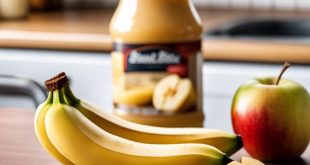Diarrhea is a common condition that can be uncomfortable and disruptive to daily life. One way to help manage this issue is through the BRAT diet. This diet consists of bananas, rice, applesauce, and toast – bland foods that are easy to digest and can help firm up stools. But what exactly is the BRAT diet and how does it work to alleviate diarrhea? Let’s explore into the details and benefits of this well-known remedy.
Table of Contents
Key Takeaways:
- BRAT diet is beneficial for managing diarrhea: The BRAT diet consists of bananas, rice, applesauce, and toast, which are bland and binding foods that can help alleviate digestive issues such as diarrhea.
- Easy on the digestive system: The simple and low-fiber nature of BRAT diet foods can reduce the frequency and severity of bowel movements, providing relief to the digestive system.
- Short-term solution: While the BRAT diet can be helpful in easing diarrhea symptoms in the short term, it is necessary to reintroduce a balanced and varied diet once the digestive system starts to recover.

History of the BRAT Diet
Development and Popularity
Popularity of the BRAT diet can be traced back to the 1920s when doctors recommended it as a bland diet for children with diarrhea. The diet consisted of Bananas, Rice, Applesauce, and Toast, hence the acronym BRAT. These bland, low-fiber foods were believed to be easy on the stomach and help firm up stools during episodes of diarrhea.
Evolution of Dietary Recommendations for Diarrhea
To understand the evolution of dietary recommendations for diarrhea, it is necessary to recognize that the BRAT diet was once the go-to solution for managing gastrointestinal distress. However, as research evolved, experts began to realize that the BRAT diet lacks necessary nutrients and may not promote adequate recovery from diarrhea. Consequently, current recommendations emphasize a more balanced approach, including a variety of foods to ensure proper nutrition and hydration during bouts of diarrhea.
With ongoing research and advancements in the field of nutrition, the BRAT diet is now viewed as a somewhat outdated approach to managing diarrhea. While it may still be recommended in certain cases, healthcare providers now generally advise a broader range of foods to ensure individuals receive the necessary nutrients to support recovery from gastrointestinal issues.
Components of the BRAT Diet
Bananas
An imperative component of the BRAT diet for diarrhea is bananas. Bananas are easily digestible and rich in potassium, which can help replace electrolytes lost during diarrhea. Additionally, they contain pectin, a soluble fiber that can help absorb liquid in the intestines and firm up stools.
Rice
The second component of the BRAT diet is rice. Plain white rice is easy on the stomach and can help bulk up stools. It is a bland carbohydrate that provides energy without irritating the digestive system.
With its low fiber content, white rice is gentle on the stomach and can help alleviate diarrhea by absorbing excess water in the intestines. It is a staple in the BRAT diet for its binding properties and ease of digestion.
Applesauce
The third component of the BRAT diet is applesauce. Applesauce is easy to digest and provides imperative nutrients such as vitamin C. It also contains pectin, which can help bulk up stools and alleviate diarrhea.
The natural sugars in applesauce can provide a quick energy boost, while its smooth texture is gentle on the stomach during bouts of diarrhea. It is a recommended food for those following the BRAT diet to help calm the digestive system.
Toast
Understanding the last component of the BRAT diet, toast is often included to provide some low-fat sustenance and help bind loose stools. It is easy to digest and can help settle an upset stomach.
Another bland carbohydrate option, toast can be comforting to eat when experiencing diarrhea. It is recommended to opt for plain, white toast without any added toppings to keep it gentle on the stomach and digestive system.
Implementing the BRAT Diet
When to Start the BRAT Diet
One crucial thing to consider when implementing the BRAT Diet is the timing of its initiation. It is advisable to start the diet once the acute symptoms of diarrhea, such as frequent loose stools and abdominal cramping, have subsided. This typically occurs after the first 24 hours of the illness.
Duration and Monitoring Progress
With regard to the duration of the BRAT Diet and monitoring progress, it is recommended to follow this eating plan for no more than 48 hours. During this time, it is important to observe any changes in the frequency and consistency of stools. If symptoms persist or worsen, medical attention should be sought.
When considering the duration and monitoring of progress while on the BRAT Diet, it is crucial to keep track of hydration levels as well. Dehydration is a common concern during episodes of diarrhea and can worsen if fluids are not replenished adequately.
Risks and Considerations
When implementing the BRAT Diet for diarrhea, it is important to be aware of potential risks and considerations. While this diet can help alleviate symptoms and promote recovery, it may not provide sufficient nutrients for sustained periods. Prolonged adherence to the BRAT Diet can lead to nutritional deficiencies, especially in children and individuals with chronic health conditions.
Considerations should also be made regarding the reintroduction of a balanced diet after following the BRAT Diet. It is advisable to gradually transition back to a regular, varied diet to ensure the body receives all crucial nutrients for overall health and well-being.

Beyond the BRAT Diet
Additional Foods to Include
With the BRAT diet being restrictive, it is imperative to introduce other easily digestible foods to provide more nutrients and aid in recovery. Foods such as cooked fruits, steamed vegetables, plain rice, boiled potatoes, bland soups, and yogurt can be included to provide a wider range of nutrients and aid in restoring gut health.
Transitioning Back to Regular Diet
An imperative aspect of recovering from diarrhea is transitioning back to a regular diet once symptoms have improved. This should be done gradually, introducing small amounts of fibrous foods like whole grains, lean proteins, and fresh fruits and vegetables. It is crucial to listen to your body and proceed at a pace that feels comfortable.
This transition phase allows the gut to slowly adapt back to normal foods without overwhelming it, reducing the risk of a relapse of symptoms. It is advisable to stay hydrated, avoid greasy or spicy foods, and monitor how your body reacts to the reintroduction of different food groups. If symptoms reappear, it may be necessary to revert temporarily to a more bland diet until the gut fully recovers.
Conclusion
With these considerations, the BRAT diet is a valuable tool for managing diarrhea, especially in children and adults. By focusing on easily digestible foods like bananas, rice, applesauce, and toast, this diet helps to alleviate symptoms and provide relief to the digestive system. While it is important to consult a healthcare professional for severe cases of diarrhea, incorporating the BRAT diet can be a helpful way to support recovery and promote overall gastrointestinal health.
FAQ
Q: What is the BRAT diet for diarrhea?
A: The BRAT diet is a well-known dietary approach recommended for managing diarrhea. BRAT stands for Bananas, Rice, Applesauce, and Toast. These bland and low-fiber foods help firm up stools and provide crucial nutrients to help ease digestive discomfort during episodes of diarrhea.
Q: Why is the BRAT diet effective for diarrhea?
A: The BRAT diet is effective for diarrhea because it consists of foods that are binding and easy to digest. Bananas help replace lost potassium, rice is starchy and helps bulk up stools, applesauce is gentle on the stomach, and toast provides a simple source of carbohydrates. These foods can help alleviate symptoms of diarrhea and promote recovery.
Q: How long should I follow the BRAT diet for diarrhea?
A: The BRAT diet is not meant to be a long-term dietary solution. It is recommended to follow the BRAT diet for up to 48 hours after the onset of diarrhea. After that, you should gradually reintroduce a normal, balanced diet to ensure you are getting all the necessary nutrients for overall health. If diarrhea persists or worsens, it is important to consult a healthcare provider for further evaluation and treatment.
 hqsportz Personal Website | Tell Information about Sport, Fashion And Health
hqsportz Personal Website | Tell Information about Sport, Fashion And Health



